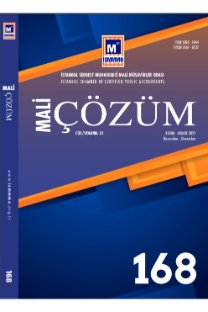BİLGİSAYAR DESTEKLİ DENETİM ARAÇ VE TEKNİKLERİNİN UYGULANMASI
Bilgisayar destekli denetim araç ve teknikleri bilgisayar ortamındaki veriyi analiz etmek için kullanılan dijital denetim yöntemleridir. Bu çalışmada temel bilgisayar destekli denetim araç ve teknikleri örneklerle açıklanmış ve bu teknikleri kullanarak çeşitli iş süreçleri için denetim modelleri geliştirilmiştir. Bilgisayarlı denetim modelleri birbirini takip eden ve birçok adımdan oluşan uygulamalardır. Aynı modelde, hatta aynı adımda, çeşitli denetim tekniklerinin birlikte kullanılması zorunludur. Bu da denetim modelini uygulamada karmaşık hale getirmektedir. Bu çalışmanın amacı denetçilerin nispeten yeni tanıştığı dijital denetim tekniklerini anlaşılır biçimde tanımlamak ve bu tekniklerin kullanımına açıklık getirmektedir. Bu çalışmanın sonucunda dijital ortamdaki kurum verisinin bilgisayar ortamında nasıl denetleneceği ortaya konmuştur. İş süreçleri bir bütün olarak ele alınmış ve tüm sürecin denetlenmesi için model geliştirilmiştir. Denetim testlerinin uygulanması sırasında bilgisayar destekli denetim araç ve tekniklerinin kullanımına açıklık getirilmiştir
APPLICATION OF COMPUTER AIDED AUDIT TOOLS AND TECHNIQUES
Computer aided audit tools and techniques are digital audit methods which are used for analyzing data in the computer environment. In this article, fundamental computer aided audit tools and techniques are explained with examples, and audit models for various business processes which use these techniques are developed. Digital auditing models are complex applications which have many steps executed in succession. It is imperative that various audit techniques are used together in the same model, or even in the same step. This complicates the audit model in practice. The aim of this study is to clarify the use of these digital audit techniques, which are relatively new to the auditors. In this study, it is shown how to audit corporate data in the digital environment. The use of computer aided audit tools and techniques during the implementation of audit tests are clarifid.
___
- Bozkurt, N. (2018). Muhasebe Denetimi, 8. bs. İstanbul: Alfa.
- Brazına, P. R. and Leauby, B. A. (2004). To CAATch a thief: Use software to fiht fraud. Accounting Today, 18 (14), 24-27.
- Chan, D. Y. and Kogan, A. (2016). Data Analytics: Introduction to Using Analytics in Auditing. Journal of Emerging Technologies in Accounting, 13 (1), 121-140.
- Chartered Institute of Internal Auditors (2019). Computer assisted audit techniques (CAATs). [Internet] Chartered Institute of Internal Auditors. Erişim adresi: https://www.iia.org.uk/resources/delivering-internal-audit/computerassisted-audit-techniques-caats/
- Coderre, D. (2009a). Computer-Aided Fraud Prevention And Detection: A Step-by-Step Guide. ABD: Wiley.
- Coderre, D. (2009b). Internal Audit. ABD: Wiley.
- Dias, C. and Marques, R. P. (2018). The use of computer-assisted audit tools and techniques by Portuguese internal auditors. 13. Iberian Conference on Information Systems and Technologies, CISTI konferansında sunulan bildiri. Caceres, İspanya, 13-16 June 2018.
- Elefterıe, L. and Badea, G. (2016). The Impact Of Informatıon Technology On The Audıt Process. Economics, Management & Financial Markets, 11 (1), 303-309.
- Gray, G. L.and Debreceny, R. S. (2014). A taxonomy to guide research on the application of data mining to fraud detection in fiancial statement audits. International Journal of Accounting Information Systems, 15(4), 357-380.
- Kardeş Selimoğlu, S., Özbirecikli, M. ve Uzay, Ş. (2017). Bağımsız Denetim, 2. bs. Ankara: Nobel.
- Lungu, I. and Vatuıu, T. (2007). Computer Assısted Audıt Technıques. Annals of the University of Petrosani Economics, 7, 217-224.
- Mahzan, N., ve Lymer, A. (2014). Examining the adoption of computerassisted audit tools and techniques: Cases of generalized audit software use by internal auditors. Managerial Auditing Journal, 29(4), 327–349. https://doi. org/10.1108/MAJ-05-2013-0877
- Mendes Pedrosa, I. M. (2015). Computer-Assisted Audıt Tools And Techniques Use: Determinants For Individual Acceptance. (Yayımlanmamış Doktora tezi), University Institute of Lisbon, Department of Information Science and Technology, Lizbon, Portekiz.
- Moeller, R. R.(2009). Brink’s Modern Internal Auditing, 7. bs. ABD: Wiley.
- Morris, M. (2014). CAATTs as Part of Your Forensic Accounting Toolbox. New Jersey CPA, 45, 24-25.
- Pathak, J. (2005). Information Technology Auditing. ABD: Springer.
- Rezaee, Z. and Riley, R. (2010). Financial Statement Fraud: Prevention and Detection. ABD: Wiley.
- Rosli, K., Yeow, P. H.P. and Siew, E.G. (2012). Factors Inflencing Audit Technology Acceptance by Audit Firms: A New I-TOE Adoption Framework. Journal of Accounting and Auditing: Research & Practice [e-dergi]. Erişim adresi: http://www.ibimapublishing.com/journals/JAARP/jaarp.html, sayı: 2012, makale no: 876814.
- Simeunovic, N., Grubor, G. Ve Ristic, N. (2016). Forensic Accounting in the Fraud Auditing Case. European Journal of Applied Economics, 13 (2), s. 45-56.
- Ünkaya, G., Dursun, G. D. (2018). İç Kontrol Sisteminin Etkinliği Arttırmada Bilgi İfşası Modelinin Kurulması. Muhasebe ve Denetime Bakış, 18, (55), 15-24.
- Vuchnich, A. (2008). Using CAATTs in Preliminary Analytical Review to Enhance the Auditor’s Risk Assessment. CPA Journal, 78 (5), s. 38-40.
- Xu, J. Ve Quaddus, M. (2013). Managing Information Systems: Ten Essential Topics. Fransa: Atlantis Press.
- ISSN: 1303-5444
- Yayın Aralığı: Yılda 6 Sayı
- Başlangıç: 1991
- Yayıncı: İstanbul Serbest Muhasebeci Mali Müşavirler Odası
Sayıdaki Diğer Makaleler
BÖLGESEL GİRİŞİMCİLİK FAALİYETLERİNİN MALİ TEŞVİK UYGULAMALARI AÇISINDAN DEĞERLENDİRİLMESİ
YÖNETİM KARARLARI AÇISINDAN KARBON MUHASEBESİ BİLGİLERİNİN ÖNEMİ
BESİCİLİK FAALİYETİNDE KAZANÇ TÜRÜNÜN BELİRLENMESİ
YÜKSEKÖĞRETİM KURUMLARINDA FAALİYET TABANLI MALİYETLEME VE VAKIF MESLEK YÜKSEKOKULUNDA BİR UYGULAMA
Mustafa KARTAL, Neşe ÇOBAN ÇELİKDEMİR
BİLGİSAYAR DESTEKLİ DENETİM ARAÇ VE TEKNİKLERİNİN UYGULANMASI
MUHASEBE VE KAPİTALİZM; TANZİMAT DÖNEMİ İKTİSADİ ZİHNİYETİ VE ŞİRKET-İ HAYRİYE MUHASEBE DÜZENİ
Pınar DALOĞLU, Miraç Sema ÜLKER
HALKA AÇIK FİNANS DIŞI ŞİRKETLERDE SÜREKLİLİK RİSKİNİN KARAR AĞACI MODELİ İLE ÖNGÖRÜLMESİ
